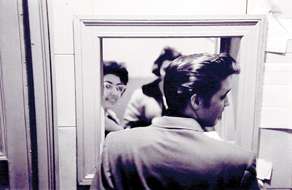Developing
Elvis
By
Michael Lollar, The Commercial Appeal (August 8, 2004)
| Alfred
Wertheimer captured images of a young man on the verge
of stardom When an RCA Records publicist called Alfred
Wertheimer to ask him to photograph the studio's new recording
star in 1956, Wertheimer said, "Elvis who?" |
 |
A
former fashion photographer's assistant, Wertheimer had hoped
for something more substantial than a lifetime of posed fashion
photos. "I was sort of brought up in the realism school of
New York ash-can photography. I was trying to become a LIFE
magazine photographer."
He
knew nothing of Elvis, but found him "frankly fascinating.
He was actually a shy person just beginning to sense that
he had something the public wanted." Elvis was the perfect
foil for Wertheimer's realism. "He permitted closeness," says
Wertheimer of a subject who seemed to live totally in the
moment, blocking out the world as he immersed himself completely
in whatever he did.
"He
hardly knew I existed. He would get absorbed. When people
get absorbed, you get good pictures." Among them is a 1956
photograph Wertheimer shot of Elvis with a toy panda on a
train trip from New York to Memphis after filming a segment
of Steve Allen's variety show.
Wertheimer,
now 74, will be in Memphis Thursday, signing posters of the
panda photograph in an after-hours 6-8 p.m. party at the Memphis
Zoo. Tickets are $10 per person, including a private viewing
of giant pandas Ya Ya and Le Le, live entertainment and Wertheimer's
stories of his brief but revealing travels with Elvis at the
dawn of his career.
To
purchase tickets, call (901) 276-9453 or visit the Web site
http://www.memphiszoo.org/home.html.
Wertheimer's
travels with Elvis covered about 10 days at different times
during 1956. They included a trip to Memphis and Elvis's home
at the time, 1034 Audubon Drive. "People think it (the photo
stint) was all year long, but it wasn't."
He
shot about 450 photographs, most of them black and white and
with some of the cost absorbed by himself. RCA only hired
Wertheimer for his work during the one recording session and
helped cover just expenses for the rest of his work. "They
were looking for back-of-album photos and newspaper publicity
shots. My deal with them was that I owned the negatives."
That clause in his contract would turn into a windfall for
Wertheimer as time went by, more than he or RCA dreamed.
Wertheimer's
photographs are now licensed through Elvis Presley Enteprises
and appear on everything from the panda posters to calendars
to photos on a variety of merchandise sold through EPE and
Graceland. "I'm probably making more money now than I've every
made before," he says.
He
was following his instincts in 1956. At the time, color film
was expensive - about $7 a roll, says Wertheimer. "The people
at RCA said, 'Don't bother shooting color. He may just be
a flash in the pan.' They didn't want to pay for the (color)
film." Wertheimer saw something in Elvis that convinced him
to invest in the color film and to follow Elvis on his own
time. Elvis's biggest hit at that point, "Heartbreak Hotel,"
might have made him a one-hit wonder.
"My
instincts told me that this young man was very unusual. Elvis
had a talent that comes along every 50 to 100 years. His voice
was great. I didn't even realize that at the time, but I have
a feeling he knew he was going to be somebody and that's why
he put up with me. If there's nobody there to record it, who's
going to know it ever happened?" Elvis even allowed Wertheimer
to photograph him as he primped in the mirror after a shower.
"He
put Vaseline hair tonic on his hair. He stood there with pimples
on his back. He had bad skin. How many people let a photogapher
into the bathroom, but he didn't care." Wertheimer, who would
later become a documentary filmmaker, says he never knew how
Elvis responded to his photographs. "He never really saw much
of it one way or the other. He was so busy being Elvis."
Although
the photographer "didn't really try to psycholanalyze Elvis,"
one of his private conclusions was that Elvis found refuge
in women. "He just didn't act natural unless he had a woman.
He needed the softness of women, somebody who wasn't competitive
with him and helped relax him . . . Girls just wanted his
body. Guys always wanted money or something else."
While
Elvis was a good listener and "laid back," he often kept to
himself. "He was always looking for privacy, like going off
into a corner somewhere or looking for a musical instrument,
any excuse for not talking." And when his mind was on his
music: "I could get within two feet of his face (with the
camera) and he would still act natural. I think it was just
his basic personality.
That's
why people in the upper balcony felt like he was singing to
them and people on the front row felt he was singing to them.
He had that kind of laser personality that allowed him to
focus in." (Spotlight/Article, Source: Elvis
World Japan/The Commercial Appeal)
|



